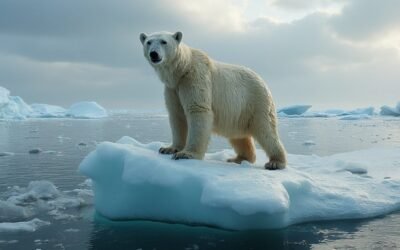Beluga whales exhibit remarkable adaptations to thrive in Arctic waters. Their blubber, up to 5 inches thick, provides essential insulation and buoyancy. These whales utilize white coloring for camouflage and have the ability to change skin color for predator evasion. They master echolocation through specialized auditory adaptations, allowing precise hunting. Socially, belugas form strong bonds via synchronized swimming and intricate vocalizations. Their ice-cracking skills enable access to food and facilitate communication through breathing holes. These quirky cold water tricks highlight the beluga's extraordinary survival strategies. Discover more about their fascinating behaviors and adaptations.
Main Points
- Beluga whales use up to 5 inches of blubber for insulation and energy reserves in frigid Arctic waters.
- Their white coloring provides effective camouflage in icy environments, offering protection from predators.
- Echolocation skills, facilitated by their melon, enable precise hunting and navigation in murky waters.
- Social behaviors like synchronized swimming and vocalizations strengthen bonds and enhance group coordination.
- Ice-cracking abilities allow access to breathing holes and food sources, ensuring survival in ice-covered regions.
Unique Blubber Insulation
Beluga whales possess a remarkable layer of blubber, up to 5 inches thick, which serves as essential insulation in the frigid waters of the Arctic and sub-Arctic regions. This unique blubber insulation offers multiple blubber benefits crucial to the survival of these marine mammals. Primarily, it acts as a crucial thermal regulation mechanism, enabling belugas to maintain a stable body temperature despite the extreme cold of their environment.
The thick blubber layer not only insulates but also provides buoyancy, allowing belugas to navigate effortlessly through icy waters. Additionally, this blubber serves as a significant energy reserve, which is particularly beneficial during periods when food is scarce. The ability of beluga whales to regulate their body temperature can be attributed to their capacity to adjust blood flow to various body parts, leveraging their blubber to either retain or release heat as needed.
This sophisticated system of thermal regulation is what allows beluga whales to thrive in some of the coldest ocean environments on Earth. By efficiently managing their body heat and energy reserves, beluga whales can endure the harsh conditions of their Arctic and sub-Arctic habitats, showcasing the incredible adaptability of these remarkable creatures.
Arctic Camouflage Techniques
Utilizing their white coloring, beluga whales seamlessly blend with the icy Arctic waters, effectively evading predators and enhancing their hunting efficiency. This distinctive white shade provides an evolutionary advantage, enabling belugas to merge with their snow-covered and icy surroundings. Their remarkable adaptation strategies include not only their innate coloring but also a unique ability to exhibit color changing skin. This allows them to adapt to varying light conditions, further enhancing their camouflage capabilities.
Beluga whales employ a range of behaviors to augment their predation avoidance techniques. For instance, they may swim close to the surface or dive to significant depths, depending on the environmental context. These strategic movements ensure that they remain inconspicuous to both prey and predators alike. The ability to alter their skin color in response to different lighting conditions is a sign of their sophisticated adaptation strategies.
These Arctic camouflage techniques underscore the beluga whale's adeptness at surviving in its frigid habitat. By mastering these peculiar cold water tricks, beluga whales not only evade predators but also improve their efficiency in stalking and capturing prey, illustrating their evolutionary advantage in the harsh Arctic environment.
Echolocation Mastery
In addition to their impressive camouflage abilities, beluga whales exhibit mastery in echolocation, a sophisticated technique crucial for maneuvering and hunting in their icy Arctic environment. Echolocation, or sound navigation, involves emitting high-pitched sounds that bounce off objects and return as echoes, providing belugas with a detailed sonic map of their surroundings.
A critical component of this process is the melon, a fatty organ located on their forehead. The melon function is to focus and direct these echolocation signals, allowing belugas to navigate through dark, murky waters with remarkable precision. This capability is particularly essential in the Arctic, where visibility is often compromised by ice and low light conditions.
Beluga whales possess specialized adaptations in their skull and auditory system, enhancing their echolocation efficiency. These adaptations make them exceptional hunters, capable of detecting and capturing small prey such as fish and squid in challenging environments.
Researchers studying beluga whales' echolocation skills have uncovered fascinating insights:
- High-pitched sound emission: Belugas produce a range of clicks and whistles.
- Echo reception: Returning echoes guide their movements.
- Skull adaptations: Unique skull structures amplify echolocation.
- Melon flexibility: The melon can alter shape to direct sound waves.
- Prey detection: Allows precise hunting even in low visibility conditions.
This echolocation mastery is a tribute to the beluga's remarkable adaptation to Arctic life.
Social Bonding Behaviors
Through synchronized swimming and vocalizations, beluga whales foster strong social bonds within their pods. These cetaceans rely heavily on intricate vocalization patterns to communicate, often producing a wide array of sounds, including clicks, whistles, and chirps. These vocalizations not only facilitate coordination during group activities but also help maintain social cohesion and reinforce individual relationships within the pod.
Beluga whales are also known for their playful interactions, which play an essential role in social bonding. Activities such as chasing one another and rubbing against each other's bodies serve to strengthen their connections. Playful behaviors are observed frequently and are vital in establishing trust and familiarity among pod members. Additionally, belugas engage in social grooming, using their teeth to meticulously clean one another's skin. This behavior further solidifies their social structures and fosters a sense of community.
Teamwork is another hallmark of beluga social behavior. When hunting, these whales demonstrate impressive cooperation, working together to corral schools of fish or squid, making it easier for all members to feed. Through mimicry and mirroring movements, belugas continuously reinforce their social ties, ensuring harmony and effective collaboration within the group.
Ice-Cracking Skills
Beluga whales exhibit remarkable ingenuity by using their powerful heads to break through thick ice, enabling them to create essential breathing holes in their Arctic habitat. This unique behavior is necessary for their survival, allowing them to surface for air in an environment where open water is often scarce. The ability to crack ice demonstrates the belugas' adaptability and intelligence, fundamental traits for maneuvering the harsh conditions of their icy domain.
By honing their ice-cracking skills, belugas can:
- Access food sources: Breaking through ice layers allows belugas to reach fish and other prey beneath the surface, showcasing their effective hunting strategies.
- Communicate with each other: The creation of breathing holes facilitates the exchange of communication signals, necessary for maintaining social bonds and coordinating group activities.
- Avoid predators: Quick access to the surface can help belugas evade threats from underwater predators.
- Navigate their environment: Ice-cracking aids in traversing their complex and ever-changing habitat.
- Ensure survival: Regularly maintaining breathing holes is essential for preventing entrapment in solid ice.
Researchers study these ice-cracking techniques to gain insights into how beluga whales thrive in extreme cold, further highlighting their remarkable adaptability and resilience.
How Do Beluga Whales’ Adaptations Help Them Perform Quirky Cold Water Tricks?
Beluga whale adaptations, such as their flexible necks and thick blubber, help them thrive in icy waters while performing unique cold-water tricks. Their ability to twist and turn in unusual ways is aided by their lack of a dorsal fin, reducing resistance and making them agile swimmers in Arctic environments.
Conclusion
The beluga whale's adaptation to Arctic environments is marked by unique blubber insulation, effective camouflage techniques, advanced echolocation, strong social bonds, and remarkable ice-cracking skills. These survival mechanisms enable belugas to thrive in extremely cold waters, underscoring their evolutionary ingenuity. Thorough understanding of these behaviors not only enriches knowledge of marine biology but also highlights the intricate balance within Arctic ecosystems. Further research could uncover additional insights into the adaptability of marine species to extreme conditions.


